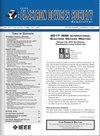Enhancing Interpretability of Neural Compact Models: Toward Reliable Device Modeling
IF 2
3区 工程技术
Q3 ENGINEERING, ELECTRICAL & ELECTRONIC
引用次数: 0
Abstract
Neural Compact Models (NCMs) have emerged as a crucial tool to meet the stringent demands of Design-Technology Co-Optimization (DTCO) and to overcome the complexities and prolonged development cycles encountered in traditional compact model creation. Despite their efficiency in simulating electronic devices, a significant barrier to the widespread adoption of NCMs in the industry remains: the lack of interpretability. In the semiconductor sector, where inaccuracies or failures can lead to considerable financial consequences, it is critical to ensure that the model’s predictions are both understandable and reliable. This study aims to enhance the interpretability of NCMs used for I-V and C-V characterizations by clarifying the physical significance of latent vectors. A regularization technique is employed to disentangle features within the latent space, and interpolation is used to visualize and elucidate each dimension’s physical impact. Our approach, which offers interpretable insights into the model’s functionality, seeks to encourage broader implementation of NCMs in the industry, thus accelerating advancements in DTCO.增强神经紧凑模型的可解释性:实现可靠的设备建模
神经集成模型 (NCM) 已成为满足设计-技术协同优化 (DTCO) 的严格要求以及克服传统集成模型创建过程中遇到的复杂性和延长开发周期的重要工具。尽管 NCM 在模拟电子设备方面非常高效,但其在行业中的广泛应用仍面临一个重大障碍:缺乏可解释性。在半导体行业,不准确或故障可能导致严重的经济后果,因此确保模型预测的可理解性和可靠性至关重要。本研究旨在通过阐明潜向量的物理意义,提高用于 I-V 和 C-V 特性分析的 NCM 的可解释性。我们采用了正则化技术来分解潜空间内的特征,并使用插值法来直观地阐明每个维度的物理影响。我们的方法为模型的功能提供了可解释的见解,旨在鼓励在行业中更广泛地实施 NCM,从而加快 DTCO 的发展。
本文章由计算机程序翻译,如有差异,请以英文原文为准。
求助全文
约1分钟内获得全文
求助全文
来源期刊

IEEE Journal of the Electron Devices Society
Biochemistry, Genetics and Molecular Biology-Biotechnology
CiteScore
5.20
自引率
4.30%
发文量
124
审稿时长
9 weeks
期刊介绍:
The IEEE Journal of the Electron Devices Society (J-EDS) is an open-access, fully electronic scientific journal publishing papers ranging from fundamental to applied research that are scientifically rigorous and relevant to electron devices. The J-EDS publishes original and significant contributions relating to the theory, modelling, design, performance, and reliability of electron and ion integrated circuit devices and interconnects, involving insulators, metals, organic materials, micro-plasmas, semiconductors, quantum-effect structures, vacuum devices, and emerging materials with applications in bioelectronics, biomedical electronics, computation, communications, displays, microelectromechanics, imaging, micro-actuators, nanodevices, optoelectronics, photovoltaics, power IC''s, and micro-sensors. Tutorial and review papers on these subjects are, also, published. And, occasionally special issues with a collection of papers on particular areas in more depth and breadth are, also, published. J-EDS publishes all papers that are judged to be technically valid and original.
 求助内容:
求助内容: 应助结果提醒方式:
应助结果提醒方式:


